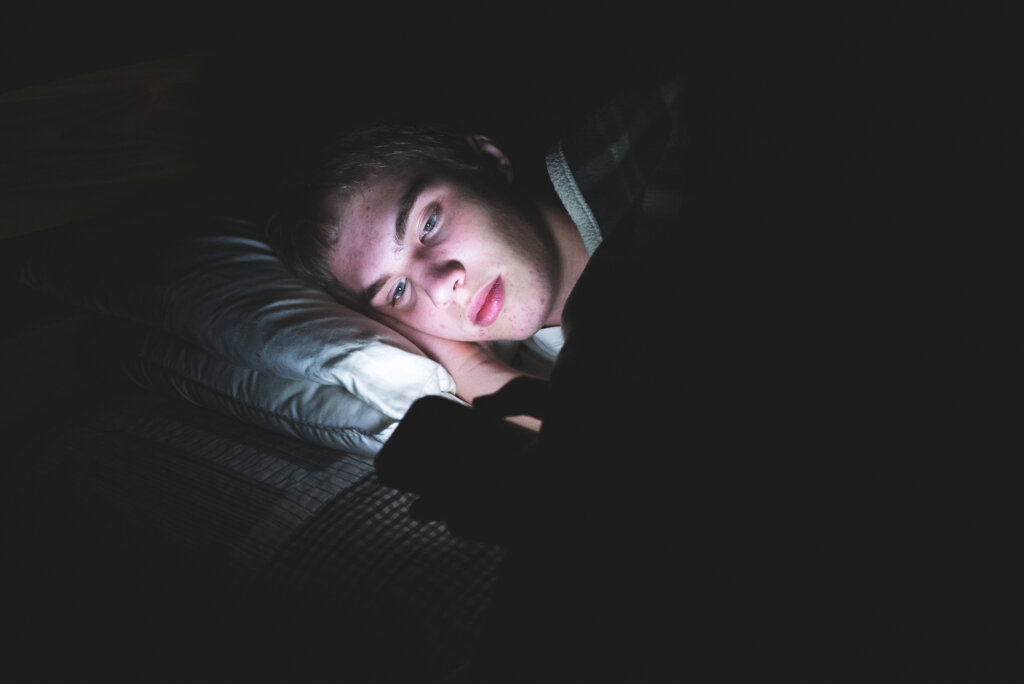Delayed Sleep Phase Syndrome in Adolescents


Reviewed and approved by the psychologist Sergio De Dios González
Adolescence is the transition stage between childhood and adulthood. It’s characterized by great changes, both in the body and the way the young person relates to the world. All of these changes, whether physical, sexual, cognitive, social, or emotional, can cause expectations and anxiety for both them and their families.
We’ve all been through the tricky teenage stage, so it’s normal to be concerned about our adolescents. In fact, during this phase, many questions might arise about what’s normal or not. Are they okay? Are they eating okay? What about sleeping? This last question is a source of anguish for many parents, caregivers, teachers, and even experts in developmental psychology.
As a matter of fact, it’s common for sleep cycles to change in adolescence. This is due to the release of melatonin. However, when do these changes become a sleep disturbance? Among the sleep disorders of adolescence, is delayed sleep phase syndrome (DSPS) We’re going to address it in this article.
Delayed sleep phase syndrome (DSPS) in adolescents
This syndrome is a sleep condition that usually affects between seven and 16 percent of adolescents. It occurs due to the alteration of the circadian rhythm. It involves the wake-sleep pattern, temperature, cognitive performance, and most other biological rhythms. DSPS usually manifests itself between the ages of 11 and 18.
According to an article in the journal, Pediatría Atención Primaria, the main characteristic of the disorder is a delay of generally more than two hours from the start and end of sleep. Sufferers exhibit insomnia at bedtime and have great difficulty getting up in the morning at the required time.

The symptoms of DSPS
In this disorder, the start and end of sleep are delayed. For example, say the young person, to get the required amount of eight hours of sleep, should go to bed at nine and get up at five in the morning. It’s more likely that they’ll fall asleep at midnight. This means it’ll be difficult for them to get up when they should.
Another important symptom is that they appear sleepy and fatigued during the day. They might also perform badly at school and show decreased attention. Moreover, in some cases, they may feel low, irritable, and sad.
The causes of delayed sleep phase syndrome in adolescents
As a rule, the cause of this disorder is unknown. That’s because of the many variables that accompany the adolescent stage of development. But, in many cases, the origin can be genetic. For example, a family history of insomnia, depression, anxiety, or sleep disorders. In fact, this stage of development is more prone to brain transformations.
Disruption of the circadian rhythm (wake/sleep cycle) can be another reason behind DSPS. It means that sufferers feel more energetic at the end of the day. We must clarify that this doesn’t occur due to their social preferences or an overload of school activities.
Diagnosis and treatment of DSPS
It’s important to consult with a sleep doctor or pediatrician about any concerns about this syndrome. Specialists will inquire about the family history and the sufferer’s medical records and make a sleep agenda. They’ll seek to identify patterns in the minor’s behavior regarding their rest habits.
Treatment is based on a gradual adjustment of sleep schedules. This is also known as sleep hygiene. Another recommendation is exposure to sunlight upon awakening and cognitive-behavioral therapy. Also, at the end of the day, excessive exposure to the brightness of the tv, computer, and other electronic devices should be avoided.

The consequences of DSPS in adolescents
Frequently, a diagnosis of DSPS affects school performance. That’s because by not being able to sleep eight hours the young person’s cognitive functions such as attention, perception, and planning are seriously altered. Regarding mood, there’s a high probability that they’ll begin to develop depressive symptoms. For instance, irritability, tearfulness, and emotional dysregulation.
Finally, it’s important to evaluate the sleep processes of adolescents we care about or with whom we live. Indeed, in many cases, these disorders correspond to a biological difficulty that requires the supervision of an expert.
Adolescence is the transition stage between childhood and adulthood. It’s characterized by great changes, both in the body and the way the young person relates to the world. All of these changes, whether physical, sexual, cognitive, social, or emotional, can cause expectations and anxiety for both them and their families.
We’ve all been through the tricky teenage stage, so it’s normal to be concerned about our adolescents. In fact, during this phase, many questions might arise about what’s normal or not. Are they okay? Are they eating okay? What about sleeping? This last question is a source of anguish for many parents, caregivers, teachers, and even experts in developmental psychology.
As a matter of fact, it’s common for sleep cycles to change in adolescence. This is due to the release of melatonin. However, when do these changes become a sleep disturbance? Among the sleep disorders of adolescence, is delayed sleep phase syndrome (DSPS) We’re going to address it in this article.
Delayed sleep phase syndrome (DSPS) in adolescents
This syndrome is a sleep condition that usually affects between seven and 16 percent of adolescents. It occurs due to the alteration of the circadian rhythm. It involves the wake-sleep pattern, temperature, cognitive performance, and most other biological rhythms. DSPS usually manifests itself between the ages of 11 and 18.
According to an article in the journal, Pediatría Atención Primaria, the main characteristic of the disorder is a delay of generally more than two hours from the start and end of sleep. Sufferers exhibit insomnia at bedtime and have great difficulty getting up in the morning at the required time.

The symptoms of DSPS
In this disorder, the start and end of sleep are delayed. For example, say the young person, to get the required amount of eight hours of sleep, should go to bed at nine and get up at five in the morning. It’s more likely that they’ll fall asleep at midnight. This means it’ll be difficult for them to get up when they should.
Another important symptom is that they appear sleepy and fatigued during the day. They might also perform badly at school and show decreased attention. Moreover, in some cases, they may feel low, irritable, and sad.
The causes of delayed sleep phase syndrome in adolescents
As a rule, the cause of this disorder is unknown. That’s because of the many variables that accompany the adolescent stage of development. But, in many cases, the origin can be genetic. For example, a family history of insomnia, depression, anxiety, or sleep disorders. In fact, this stage of development is more prone to brain transformations.
Disruption of the circadian rhythm (wake/sleep cycle) can be another reason behind DSPS. It means that sufferers feel more energetic at the end of the day. We must clarify that this doesn’t occur due to their social preferences or an overload of school activities.
Diagnosis and treatment of DSPS
It’s important to consult with a sleep doctor or pediatrician about any concerns about this syndrome. Specialists will inquire about the family history and the sufferer’s medical records and make a sleep agenda. They’ll seek to identify patterns in the minor’s behavior regarding their rest habits.
Treatment is based on a gradual adjustment of sleep schedules. This is also known as sleep hygiene. Another recommendation is exposure to sunlight upon awakening and cognitive-behavioral therapy. Also, at the end of the day, excessive exposure to the brightness of the tv, computer, and other electronic devices should be avoided.

The consequences of DSPS in adolescents
Frequently, a diagnosis of DSPS affects school performance. That’s because by not being able to sleep eight hours the young person’s cognitive functions such as attention, perception, and planning are seriously altered. Regarding mood, there’s a high probability that they’ll begin to develop depressive symptoms. For instance, irritability, tearfulness, and emotional dysregulation.
Finally, it’s important to evaluate the sleep processes of adolescents we care about or with whom we live. Indeed, in many cases, these disorders correspond to a biological difficulty that requires the supervision of an expert.
All cited sources were thoroughly reviewed by our team to ensure their quality, reliability, currency, and validity. The bibliography of this article was considered reliable and of academic or scientific accuracy.
- Alcántara, M. La importancia de respetar el ciclo del sueño vigilia. Gobierno de México. http://www.incmnsz.mx/opencms/contenido/departamentos/CAIPaDi/boletines/boletinmayo2020-1.html#:~:text=El%20ritmo%20circadiano%20de%20sue%C3%B1o,interacci%C3%B3n%20intercelular%20(relojes%20biol%C3%B3gicos).
- Allen, B., Waterman, H. (2019). Etapas de la adolescencia. American Academy of Pediatrics. https://www.healthychildren.org/Spanish/ages-stages/teen/Paginas/Stages-of-Adolescence.aspx
- Giménez Badia, S., Albares Tendero, J., Canet Sanz, T., Jurado Luque, M., Madrid Pérez, J., Merino Andreu, M. & Sellés Galiana, F. (2016). Trastorno de retraso de la fase del sueño y del despertar. Síndrome de retraso de fase. Pediatría Atención Primaria, 18(71), e129-e139. https://www.redalyc.org/pdf/3666/366649606017.pdf
- Mas, M. (2021). Síndrome del retraso de fase, adolescentes que no se duermen. Neruonas en crecimiento. https://neuropediatra.org/2021/12/12/sindrome-del-retraso-de-fase-adolescentes-que-no-se-duermen/
- Morera Sanz, M., & Santana Escalante, C. (2019). Síndrome del retraso de fase (sueño) en el adolescente. Familia y salud. https://www.familiaysalud.es/vivimos-sanos/sueno/trastornos-del-sueno/sindrome-de-retraso-de-fase-sueno-en-el-adolescente
- En familia AEP. Sueño en el adolescente. Síndrome del retraso de fase. En familia AEP. https://enfamilia.aeped.es/edades-etapas/sueno-en-adolescente-sindrome-retraso-fase
This text is provided for informational purposes only and does not replace consultation with a professional. If in doubt, consult your specialist.







